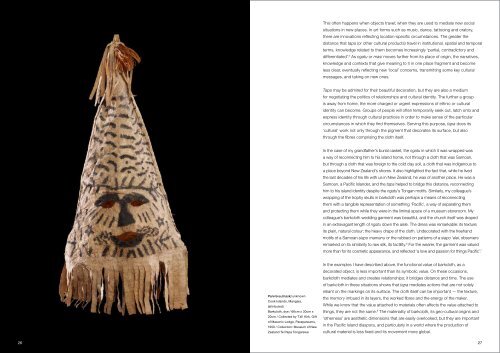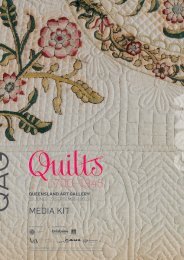Paperskin: barkcloth across the Pacific - Queensland Art Gallery
Paperskin: barkcloth across the Pacific - Queensland Art Gallery
Paperskin: barkcloth across the Pacific - Queensland Art Gallery
Create successful ePaper yourself
Turn your PDF publications into a flip-book with our unique Google optimized e-Paper software.
26<br />
Pare’eva (mask) unknown<br />
Cook Islands, Mangaia,<br />
(attributed)<br />
Barkcloth, dye / 66cm x 30cm x<br />
20cm / Collected by T.W. Kirk. Gift<br />
of Masonic Lodge, Paraparaumu,<br />
1950 / Collection: Museum of New<br />
Zealand Te Papa Tongarewa<br />
This often happens when objects travel; when <strong>the</strong>y are used to mediate new social<br />
situations in new places. in art forms such as music, dance, tattooing and oratory,<br />
<strong>the</strong>re are innovations reflecting location-specific circumstances. The greater <strong>the</strong><br />
distance that tapa (or o<strong>the</strong>r cultural products) travel in institutional, spatial and temporal<br />
terms, knowledge related to <strong>the</strong>m becomes increasingly ‘partial, contradictory and<br />
differentiated’. 5 As ngatu or masi moves fur<strong>the</strong>r from its place of origin, <strong>the</strong> narratives,<br />
knowledge and contexts that give meaning to it in one place fragment and become<br />
less clear, eventually reflecting new ‘local’ concerns, transmitting some key cultural<br />
messages, and taking on new ones.<br />
Tapa may be admired for <strong>the</strong>ir beautiful decoration, but <strong>the</strong>y are also a medium<br />
for negotiating <strong>the</strong> politics of relationships and cultural identity. The fur<strong>the</strong>r a group<br />
is away from home, <strong>the</strong> more charged or urgent expressions of ethnic or cultural<br />
identity can become. Groups of people will often temporarily seek out, latch onto and<br />
express identity through cultural practices in order to make sense of <strong>the</strong> particular<br />
circumstances in which <strong>the</strong>y find <strong>the</strong>mselves. serving this purpose, tapa does its<br />
‘cultural’ work not only through <strong>the</strong> pigment that decorates its surface, but also<br />
through <strong>the</strong> fibres comprising <strong>the</strong> cloth itself.<br />
in <strong>the</strong> case of my grandfa<strong>the</strong>r’s burial casket, <strong>the</strong> ngatu in which it was wrapped was<br />
a way of reconnecting him to his island home, not through a cloth that was samoan,<br />
but through a cloth that was foreign to <strong>the</strong> cold clay soil, a cloth that was indigenous to<br />
a place beyond New Zealand’s shores. it also highlighted <strong>the</strong> fact that, while he lived<br />
<strong>the</strong> last decades of his life with us in New Zealand, he was of ano<strong>the</strong>r place. he was a<br />
samoan, a <strong>Pacific</strong> islander, and <strong>the</strong> tapa helped to bridge this distance, reconnecting<br />
him to his island identity despite <strong>the</strong> ngatu’s Tongan motifs. similarly, my colleague’s<br />
wrapping of <strong>the</strong> trophy skulls in <strong>barkcloth</strong> was perhaps a means of reconnecting<br />
<strong>the</strong>m with a tangible representation of something ‘<strong>Pacific</strong>’, a way of separating <strong>the</strong>m<br />
and protecting <strong>the</strong>m while <strong>the</strong>y were in <strong>the</strong> liminal space of a museum storeroom. My<br />
colleague’s <strong>barkcloth</strong> wedding garment was beautiful, and <strong>the</strong> church itself was draped<br />
in an extravagant length of ngatu down <strong>the</strong> aisle. The dress was remarkable: its texture;<br />
its plain, natural colour; <strong>the</strong> heavy drape of <strong>the</strong> cloth. undecorated with <strong>the</strong> freehand<br />
motifs of a samoan siapo mamanu or <strong>the</strong> rubbed-on patterns of a siapo ’elei, observers<br />
remarked on its similarity to raw silk, its tactility. 6 For <strong>the</strong> wearer, <strong>the</strong> garment was valued<br />
more than for its cosmetic appearance, and reflected ‘a love and passion for things <strong>Pacific</strong>’. 7<br />
in <strong>the</strong> examples i have described above, <strong>the</strong> functional value of <strong>barkcloth</strong>, as a<br />
decorated object, is less important than its symbolic value. On <strong>the</strong>se occasions,<br />
<strong>barkcloth</strong> mediates and creates relationships; it bridges distance and time. The use<br />
of <strong>barkcloth</strong> in <strong>the</strong>se situations shows that tapa mediates actions that are not solely<br />
reliant on <strong>the</strong> markings on its surface. The cloth itself can be important — <strong>the</strong> texture,<br />
<strong>the</strong> memory imbued in its layers, <strong>the</strong> worked fibres and <strong>the</strong> energy of <strong>the</strong> maker.<br />
While we know that <strong>the</strong> value attached to materials often affects <strong>the</strong> value attached to<br />
things, <strong>the</strong>y are not <strong>the</strong> same. 8 The materiality of <strong>barkcloth</strong>, its geo-cultural origins and<br />
‘o<strong>the</strong>rness’ are aes<strong>the</strong>tic dimensions that are easily overlooked, but <strong>the</strong>y are important<br />
in <strong>the</strong> <strong>Pacific</strong> island diaspora, and particularly in a world where <strong>the</strong> production of<br />
cultural material is less fixed and its movement more global.<br />
27

















